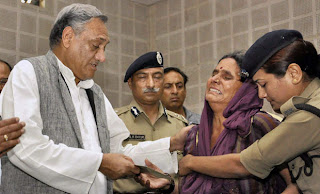In a meeting with the Special Representative to the Secretary General of the United Nations, Ms. Margarita Wohlstrom held at the India Habitat Center in a meeting of UN and few select representatives for reviewing the suggestions that have risen from various consultations across the country on looking beyond the Hyogo Framework for Action, I mentioned that "If we do not move ahead of the disasters they would catch, and in fact they have already caught up, with us. If we do not catch up with disasters they would catch up with us. Are we chasing disasters? It is not about doing better against each disaster, but is about doing better to minimize risks against future disasters."
Look at a dozen of major disasters that stuck us in the last year. We have lost over 20,000 lives, and have gone backward in billions of dollars on pure economic terms. All our responses have been getting better and more humane. Our reconstruction activities have been more and more getting standardized. But look at the linkage between development and disaster. There is still a vast gap. We just do not want to bridge it just how how hard it may look to be. None of the nations and states want to lose a pie by way of development matrix, but would not mind to lose a million in terms of hazards--both generated and responded.
One key indicator if we look at is waste generation and waste recycling. Waste has huge impact on the environment and can lead to several new hazards or increase exposure to such hazards. Look at the kind of E-Waste that we are generating. And then look at the municipal wastes. It is out rightly not in proportion. But by the fact that we are generating more e-waste, is a sign that "we are developing" (?). In fact the amount of e-waste generated would be 33% higher in 2017 in comparison to 2012. "The average Canadian, for example, generated about 24 kilograms of e-waste in 2012. That’s more than 860,000 tonnes for the entire country, roughly equivalent to the weight of about 1,700 fully loaded Boeing 747s at take off." (Source: The Star.Com )
How fast is our recycling units growing? The highest of waste recycled according to World Mapper is in Netherlands, and what is the percentage -- 45.2%, and then it keeps dropping drastically but for few rich and highly environment conscious countries. In other words, even Netherlands is left with more than half of its waste every year. In this order, if we look at any of the other key indicator, air pollution, green house emissions, forestation, population management, and all these have a sad story to tell.
Probably we are fighting a losing battle, unless we take up seriously issues that contribute to hazards and get ahead of disasters before they keep going ahead of us. Or else, we will literally be chasing the wind!
















